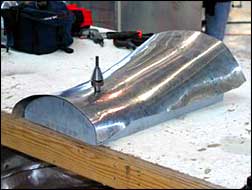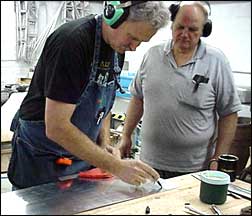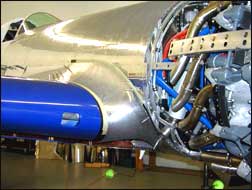Fairing or Saddle Dies
Our "Fairing" or Saddle or Reverse dies are for stretching more in one direction than in any other, in order
to make convex curved flanges, saddle, reverse, or fairing shapes.
These "linear", or "coherent" stretching dies move the metal specifically at a 90deg. angle to the length of
the die. The dies are roughly a chisel-shape that can be carefully modified for specific tasks.
This lower "chisel" die must be oriented in the die holder and held that way during the working process in
order to work, even if a band of good tape is needed to hold it.
The machine using these dies must be set very accurately.
Usually the die is used to "open up", lengthen, or stretch the edge of a panel, a flange, or an angle, creating an arch or a reverse curve along this edge.
Applied commonly to "fairings" or "fillets" on many aircraft, these shapes may be worked along two opposing edges, along three edges, or along all four sides.
Used to make flares, ducktails or saddle shapes on cars, these shapes may be seen on the cowls of midgets,
modifieds, and dragsters and as spoilers on the rear decks of 60's era Ferraris and such
sports-racing models.
-- Kent White
To: Air Hammer Tooling for Reverses, Fairings, and Saddles

Back to Articles by the Tinman





